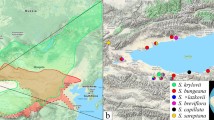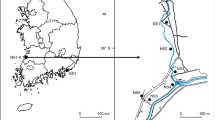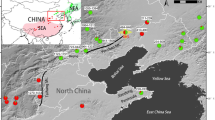Abstract
The two widespread species of oak tree in Europe, Quercus robur L. and Q. petraea (Matt.) Liebl., hybridize extensively, calling their taxonomic status into question. Here we use microsatellite DNA, a highly informative genetic marker, to show that Q. robur and Q. petraea are discrete taxonomic units despite this intensive hybridization. Furthermore, individual oaks can be assigned to separate species.
Similar content being viewed by others
Main
Oaks are a classic example of a taxonomic group that has significantly challenged existing species concepts1, of which the ‘biological species concept’ is the most popular. Two European species, Q. robur and Q. petraea, hybridize without any significant mating barriers2. Despite the high gene flow between them, the two species show clear differences in leaf and fruiting structures3. The two species are largely sympatric, but there are some habitat differences: Q. robur grows in wetter and more alkaline habitats, whereas Q. petraea is more drought resistant.
In contrast to morphological characters and ecological preferences, it is difficult to find any interspecific differences using molecular markers. Chloroplast markers were found to be polymorphic, but could not discriminate between Q. robur and Q. petraea4,5. Similarly, the two species show very similar RAPD and allozyme frequencies6,7,8; nor did ITS sequences, a popular marker for species determination, reveal any interspecific differences (G.M., C.C.F. and C.S., manuscript submitted).
The taxonomic status of oaks has implications for forest management. Given the two species' different habitat preferences, the European Community, seeking to avoid the use of maladapted seed, has established guidelines for the trade of oak seed material (71/161/EWG, 30.3.1971). According to these, each seed lot must not contain more than 0.1% of seeds from another species. But without unambiguous criteria for taxonomic classification, this guideline cannot be put into practice.
We used microsatellite analysis, which has been shown to discriminate between closely related species9, to address the question of species status in Q. robur and Q. petraea. To account for geographic differences, we sampled one population (approximately 16 individuals) from each species at five locations that covered almost all the species' European range. If Q. robur and Q. petraea are good taxonomic units, then populations should cluster according to species rather than geographic origin. Figure 1 shows a dendrogram based on the proportion of shared alleles10 at 20 microsatellite loci. In accordance with the assumption that Q. robur and Q. petraea are separate taxonomic units, all populations of the same species group together. This separation between the two species has very strong bootstrap support (100%). F-statistics also indicate a significant difference between the two species (P<0.01), although there is also a significant component of variation due to the geographic origin of the population ( P<0.01).
One population from each species was sampled at five locations. The dendrogram was computed using a UPGMA approach in PHYLIP12. Numbers are bootstrap support values.
In the light of the EC's requirement for unmixed seed lots, we tested whether the genotypic information from the 20 loci typed for both species is sufficient to identify the species of an individual. Eighty-one oak samples from Ireland, which were not included in the previous analysis, were typed using the same set of microsatellites. Using an assignment test based on allele frequencies11, we determined the species status of those 46 samples that had either a clear Q. robur or Q. petraea phenotype, based on three characters of leaf morphology (petiole length/lamina length, auricle development and mid-rib pubescence). For no individual was the incorrect species assigned. Morphological and molecular evidence agreed in 78% of cases. In 22% of the cases, the molecular analysis was either not informative (7%) or indicated a hybrid status (15%).
Our molecular analysis demonstrates that Q. robur and Q. petraea are separate taxonomic units, which can be designated by the use of microsatellites. The important question remains as to how the species differences are maintained despite the high levels of interspecific gene flow.
References
Burger, W. C. Taxon 24, 45–50 ( 1975).
Bacilieri, R., Ducousso, A., Petit, R. J. & Kremer, A. Evolution 50, 900–908 ( 1996).
Rushton, B. S. Irish Forestry 40, 52–77 (1983).
Ferris, C., Oliver, R. P., Davy, A. J. & Hewitt, G. M. Mol. Ecol. 2, 337–344 ( 1993).
Dumolin-Lapègue, S., Kremer, A. & Petit, R. J. Evolution 53, 1406– 1413 (1999).
Bodénès, C., Joandet, S., Laigret, F. & Kremer, A. Heredity 78, 433–444 (1997).
Samuel, R. Plant Syst. Evol. 217, 137–146 (1999).
Zanetto, A., Roussel, G. & Kremer, A. Forest Genet. 1, 111– 123 (1994).
Harr, B., Weiss, S., David, J. R., Brem, G. & Schlötterer, C. Curr. Biol. 8, 1183– 1186 (1998).
Minch, E., Ruiz-Linares, A., Goldstein, D., Feldman, M. & Cavalli-Sforza, L. L. http://lotka.stanford.edu/microsat/microsat.html (1995).
Cornuet, J.-M, Piry, S., Luikart, G., Estoup, A. & Solignac, M. Genetics 153, 1989– 2000 (1999).
Felsenstein, J. Cladistics 5, 164–166 ( 1989).
Author information
Authors and Affiliations
Corresponding author
Rights and permissions
About this article
Cite this article
Muir, G., Fleming, C. & Schltterer, C. Species status of hybridizing oaks. Nature 405, 1016 (2000). https://doi.org/10.1038/35016640
Issue Date:
DOI: https://doi.org/10.1038/35016640
This article is cited by
-
An oak is an oak, or not? Understanding and dealing with confusion and disagreement in biological classification
Biology & Philosophy (2023)
-
Morphology, geometric morphometrics, and taxonomy in relict deciduous oaks woods in northern Italy
Rendiconti Lincei. Scienze Fisiche e Naturali (2021)
-
Phylogeography and phylogeny of genus Quercus L. (Fagaceae) in Turkey implied by variations of trnT(UGU)-L(UAA)-F (GAA) chloroplast DNA region
Tree Genetics & Genomes (2021)
-
Species diversification in a lineage of Mexican red oak (Quercus section Lobatae subsection Racemiflorae)—the interplay between distance, habitat, and hybridization
Tree Genetics & Genomes (2019)
-
A novel set of single-copy nuclear gene markers in white oak and implications for species delimitation
Tree Genetics & Genomes (2017)
Comments
By submitting a comment you agree to abide by our Terms and Community Guidelines. If you find something abusive or that does not comply with our terms or guidelines please flag it as inappropriate.




